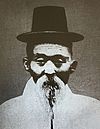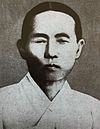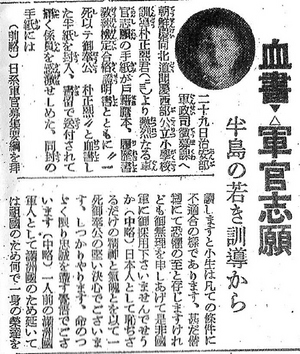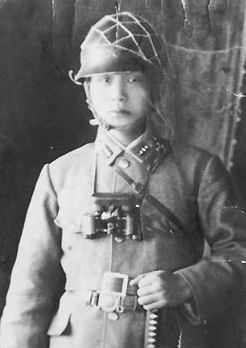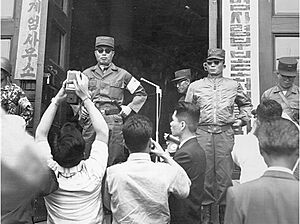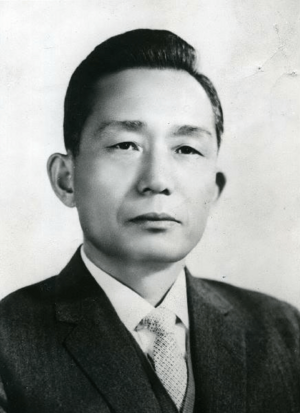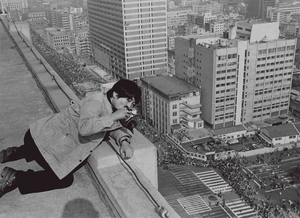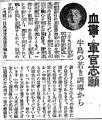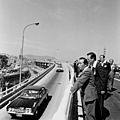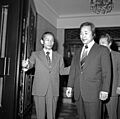Park Chung Hee facts for kids
Quick facts for kids
Park Chung Hee
|
|
|---|---|
|
박정희
|
|
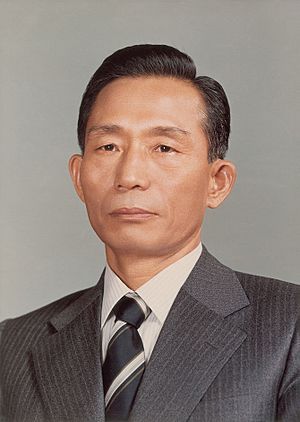
Official portrait, c. 1963–1979
|
|
| 3rd President of South Korea | |
| In office March 24, 1962 – October 26, 1979 Acting to December 17, 1963 |
|
| Prime Minister |
|
| Preceded by | Yun Po-sun |
| Succeeded by | Choi Kyu-hah |
| Prime Minister of South Korea Acting |
|
| In office June 16, 1962 – July 10, 1962 |
|
| President | Himself |
| Preceded by | Song Yo-chan |
| Succeeded by | Kim Hyun-chul |
| Chairman of the Supreme Council for National Reconstruction | |
| In office July 3, 1961 – December 17, 1963 |
|
| Preceded by | Chang Do-yong |
| Succeeded by | Position abolished |
| Deputy Chairman of the Supreme Council for National Reconstruction | |
| In office May 16, 1961 – July 2, 1961 |
|
| Preceded by | Position established |
| Succeeded by | Position abolished |
| Personal details | |
| Born | November 14, 1917 Gumi, Keishōhoku-dō (North Gyeongsang), Korea, Empire of Japan |
| Died | October 26, 1979 (aged 61) Jongno District, Seoul, South Korea |
| Cause of death | Assassination |
| Resting place | Seoul National Cemetery |
| Political party | Democratic Republican |
| Other political affiliations |
Workers' Party of South Korea (1946–1948) |
| Spouses |
Kim Ho-nam
(m. 1936; div. 1950)Yuk Young-soo
(m. 1950; died 1974) |
| Children | Park Jae-ok Park Geun-hye Park Geun Ryeong Park Ji-man |
| Education | Manchukuo Army Military Academy Imperial Japanese Army Academy Korea Military Academy |
| Religion | Buddhism |
| Signature |  |
| Military service | |
| Allegiance | Empire of Japan Second Republic of Korea |
| Branch/service | Manchukuo Imperial Army (1944–1945) Republic of Korea Army (1945–1963) |
| Years of service | 1944–1963 |
| Rank | General |
| Battles/wars | World War II Korean War |
| Korean name | |
| Hangul |
박정희
|
| Hanja | |
| Revised Romanization | Bak Jeonghui |
| McCune–Reischauer | Pak Chŏnghŭi |
| Art name | |
| Hangul |
중수
|
| Hanja | |
| Revised Romanization | Jungsu |
| McCune–Reischauer | Chungsu |
Park Chung Hee (Korean: 박정희 November 14, 1917 – October 26, 1979) was a powerful leader in South Korea. He was an army general who became the third President of South Korea in 1963. He took power after a military takeover in 1961. Park ruled the country for 16 years until he was killed in 1979.
Park is seen as a very important figure in Korean history. He is known for helping South Korea's economy grow very quickly. This period is often called the "Miracle on the Han River". However, his time in power was also controversial because he ruled like a dictator. He limited people's freedoms and controlled the government very strictly, especially after 1972.
Contents
Early Life and Education
Park Chung Hee was born on November 14, 1917, in Gumi, a town in what is now North Gyeongsang Province, Korea. His family was very poor. He was the youngest of seven children.
School Days and Challenges
Park started elementary school when he was nine years old. His school was about 6 kilometers (4 miles) from his home. He often walked this distance every day. He was a good student and got good grades, even though he was often hungry and sick.
He was usually one of the shortest students. His school records often described him as not very strong. Despite this, he was a very determined and competitive child. He loved reading history books and admired heroes like Napoleon and the Korean Admiral Yi Sun-sin.
In 1932, Park went to Taegu Normal School. This school trained elementary school teachers. It was hard to get into, but it was free. This was important because his family was struggling financially. The school had a military style, and Park enjoyed the military training. He became interested in joining the army instead of becoming a teacher.
Military Career
Park wanted to join the military, but he was too old for the Manchukuo Army Military Academy. To show how serious he was, he wrote a letter in his own blood saying he would "Service Until Death" for Japan. This act helped him get accepted into the academy in 1939.
Joining the Army
Park did very well at the Manchukuo Army Military Academy. He was good at Japanese and was used to military life. He even used a Japanese name, Takagi Masao. He graduated as one of the top students in 1942.
His skills were noticed, and he was allowed to attend the Imperial Japanese Army Academy near Tokyo. After graduating, he served in the Japanese Army in Manchuria until World War II ended.
Return to Korea and the Korean War
After World War II, Park returned to Korea. He joined the Korea Military Academy and became an officer in the new South Korean army. In 1948, he was arrested because he was suspected of being involved with a Communist group. He was sentenced to death, but his sentence was changed. He was forced out of the army.
When the Korean War started in 1950, Park was able to rejoin the army. He quickly rose through the ranks. By the end of the war in 1953, he was a brigadier general. He even went to the United States for military training.
Park continued to gain power in the military. By 1960, he was one of the most important figures in the South Korean army.
Becoming President
In 1960, the first South Korean president, Syngman Rhee, was forced to leave office after student protests. The new government struggled with a bad economy and lots of protests. People were unhappy and the country was unstable.
The Military Takeover
In this chaotic situation, Major General Park Chung Hee formed a group called the Military Revolutionary Committee. On May 16, 1961, this group carried out a military takeover. Park became the main leader of the new military government. Many people in South Korea welcomed the takeover because they were tired of the political problems.
Park was promoted to general. He quickly set up the Korean Central Intelligence Agency (KCIA) to stop any challenges to his power. The KCIA had the power to arrest anyone suspected of being against the government.
In 1963, Park held an election and was chosen as the third President of South Korea. He won by a small number of votes. He was re-elected in 1967.
Leading South Korea
Park Chung Hee's main goal was to end poverty in South Korea. He wanted to turn the country into a strong, modern economy.
Helping the Economy Grow
Park started "Five Year Plans" to guide the economy. He focused on building industries that could export goods to other countries. He created special industrial zones and built large companies called chaebols. These were family-owned businesses that grew very big with government support. Famous examples include Hyundai, LG, and Samsung.
When Park took power in 1961, South Korea was very poor. By the 1970s, it was one of the fastest-growing economies in the world. This amazing growth is known as the "Miracle on the Han River". Electricity became available 24 hours a day, and more factories were built. Poverty was greatly reduced, and people's lives improved.
Relations with Other Countries
In 1965, Park signed a treaty to normalize relations with Japan. This helped increase trade and investment between the two countries.
South Korea also sent many troops to fight alongside the United States in the Vietnam War. This helped strengthen South Korea's relationship with the U.S. and brought money and technology to South Korea.
Park also had a complex relationship with North Korea. There were many clashes along the border. In 1968, North Korean commandos tried to assassinate Park. Despite this, there were also talks about reuniting the two Koreas, but these did not lead to a lasting peace.
In 1974, there was another assassination attempt on Park while he was giving a speech. He was not hurt, but his wife, Yuk Young-soo, was killed by a stray bullet.
Changes at Home
After his second term, Park promised to step down in 1971. However, he changed the constitution to allow himself to run for a third term. He won a close election in 1971.
In 1972, Park declared martial law and changed the constitution again. This new constitution, called the Yushin Constitution, gave him much more power. He could rule by special orders and limit people's freedoms. This made him a dictator. He argued that South Korea needed a strong leader to be stable and grow.
During this time, he launched the Saemaul Undong (New Village Movement). This program aimed to modernize the countryside by bringing electricity and running water to farms and improving homes.
Park also made hangul (the Korean alphabet) the only writing system used in public schools and the military. This helped reduce illiteracy in South Korea.
Later Years and Death
As the 1970s went on, many South Koreans became unhappy with Park's strict rule. People wanted more freedom and democracy. Protests started to grow across the country.
His Final Years
In October 1979, large student protests began in the cities of Busan and Masan. Students and citizens demanded an end to Park's dictatorship. The government declared martial law in these cities.
Assassination
On October 26, 1979, Park Chung Hee was shot and killed by Kim Jae-gyu, the director of the KCIA. This happened after a dinner at a safe house in Seoul. Other presidential guards were also killed. Kim Jae-gyu and his group were later arrested and executed.
It's still not completely clear why Kim Jae-gyu killed Park. Some believe it was to bring democracy, while others think it was to keep his own power.
After Park's death, Choi Kyu-hah became acting president. However, another military leader, Chun Doo-hwan, quickly took control of the military and the government.
Park Chung Hee was buried with military honors at the Seoul National Cemetery.
Personal Life
Park Chung Hee was married twice. He had one daughter with his first wife, Kim Ho-nam. He later divorced her. Then he married Yuk Young-soo. They had two daughters and one son. His second wife, Yuk Young-soo, was killed in an assassination attempt against him in 1974.
His eldest daughter from his second marriage, Park Geun-hye, later became the 11th president of South Korea in 2013. She was the first female president of the country. Her presidency ended in 2017 when she was removed from office.
His Legacy
Park Chung Hee remains a very debated figure in South Korea. Some people praise him for making South Korea economically strong and modern. They believe he protected the country and led it to global importance. Older generations often remember him positively for these achievements.
However, others criticize his authoritarian rule, especially after 1971. They argue that he limited civil liberties and human rights in favor of economic growth and order.
Despite the controversy, polls have shown that many South Koreans, especially older citizens, still view him as one of the most highly rated presidents in the country's history.
Images for kids
-
Park with U.S. President John F. Kennedy in Washington, D.C., on November 14, 1961
-
Park (third left) at the 1966 SEATO convention in the Philippines
-
Park with Willy Brandt in West Germany, 1964
-
Park with future President Kim Young-sam in 1975
See also
 In Spanish: Park Chung-hee para niños
In Spanish: Park Chung-hee para niños


